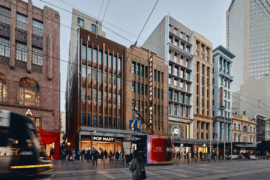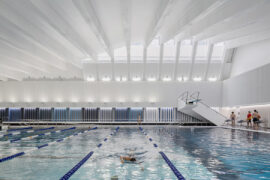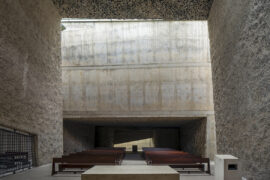Step inside BVN’s West Wing refurb for the TC Beirne School of Law and Walter Harrison Law Library within the University of Queensland’s famed Forgan Smith Building.
In some ways, the refurbishment of this flagship University of Queensland building was a straightforward prospect. With its old-fashioned double-loaded corridors that previous occupants had likened to prisons or hospitals, there was plenty of scope for improvement. But it was a daunting project too. As the university’s oldest structure, the Forgan Smith Building is an iconic example of the Stripped Classical Style in Brisbane, and it forms part of the university’s beloved quadrangle, so any interventions had to be sensitive and respectful.
For Lucas Leo, architect and senior associate at BVN, the overhaul of the building’s west wing – home to UQ’s Law School and Library – presented an enjoyable challenge. “The building was completed in 1948, and had been adapted over time, and most of the services were at the end of their life,” he says. “Like all universities, there is global competition to attract talent – students, staff, academics and researchers – and we wanted to create memorable experiences for them.”
The project involved bringing all of the Law faculty’s activities back into one location after they’d been scattered across campus, with a focus on smaller classes of around 40 students. The building was strategically re-planned to integrate three sections: research and operations suites; the central learning zone, which include a moot court and event space; and the faculty’s extensive library collections and new collaborative student spaces. Interior zones are identified by different colour palettes from the legal industry – such as the purple from the law graduation sash, and the rich hues of illuminated manuscripts – with common materials and tones tying them together across the wing.
BVN’s boldest intervention was the incision of a new vertical volume defined by a translucent screen, which rises from the ground floor entrance through the first and second floors. This arrival hall, as Leo calls it, creates a remarkable public room for the school, and provides new circulation and serendipitous meeting places. “In effect, that space is the Law School’s front of house, both on campus and internationally,” Leo says.
As well as creating new sightlines upwards and along the corridors, BVN opted to raise the roof on the upper level by 500mm created more usable floor space. “It’s part of a broader strategy of the University: to increase the amount of useable space while using the same footprint,” Leo says.
The upper level has a distinct character now, thanks to a series of new sculptural ceiling vaults that were informed by the arches of the university’s Great Court. These profiles were replicated in parts of the lower floors, to create similarly scaled spaces throughout.
“We worked within the significance parameters identified in the Conservation Management Plan, to adjust the fabric to suit contemporary needs of teaching and learning,” Leo says. “The double‐loaded corridor arrangement was deemed significant, and we’ve maintained that, but it was rebuilt by inserting the existing silky oak doors and highlights within glazed partitions, to enable light to penetrate much deeper into the spaces.
“Now, the interior has a new level of transparency and openness that creates opportunities for engagement and collaboration,” Leo says. “We are told the refurbishment has changed the research culture of the school, which was one of the main drivers of the project.”
INDESIGN is on instagram
Follow @indesignlive
A searchable and comprehensive guide for specifying leading products and their suppliers
Keep up to date with the latest and greatest from our industry BFF's!

Merging two hotel identities in one landmark development, Hotel Indigo and Holiday Inn Little Collins capture the spirit of Melbourne through Buchan’s narrative-driven design – elevated by GROHE’s signature craftsmanship.

From the spark of an idea on the page to the launch of new pieces in a showroom is a journey every aspiring industrial and furnishing designer imagines making.

Hiwa, the University of Auckland’s six-storey recreation centre by Warren and Mahoney with MJMA Toronto and Haumi, has taken out Sport Architecture at the 2025 World Architecture Festival. A vertical village for wellbeing and connection, the project continues its run of global accolades as a new benchmark for campus life and student experience.

The World Architecture Festival has named The Holy Redeemer Church and Community Centre of Las Chumberas in La Laguna, Spain as World Building of the Year 2025, alongside major winners in interiors, future projects and landscape.
The internet never sleeps! Here's the stuff you might have missed

In creating interior spaces that enhance the wellbeing and experience of people, true responsible sourcing also considers the impact of materials and making.

Working within a narrow, linear tenancy, Sans Arc has reconfigured the traditional circulation pathway, giving customers a front row seat to the theatre of Shadow Baking.